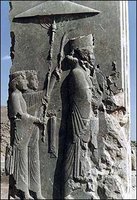King Xerxes I ( khashayar shah)

Xerxes I (modern Persian spelling خشایارشاه), was a Persian Empire (reigned 485 - 465 BC) of the Achaemenid dynasty. "Xerxes" is the Greek transliteration of the Persian throne name Khshayarsha or Khsha-yar-shah, meaning "ruler of heroes". In the Book of Ezra and in Book of Esther, the Persian king Axašweroš (אֲחַשְׁוֵרוֹשׁ) probably corresponds to Xerxes I.Xerxes became king of Persia at the death of his father Darius the Great in 485, at a time when his father was preparing a new expedition against Greece and had to face an uprising in Egypt (Herodotus' Histories, VII, 1-4). According to Herodotus, the transition was peaceful this time. Because he was about to leave for Egypt, Darius, following the law of his country had been requested to name his successor and to choose between the elder of his sons, born from a first wife before he was in power, and the first of his sons born after he became king, from a second wife, Atossa, Cyrus' daughter, who had earlier been successively wed to her brothers Cambyses and Smerdis, and which he had married soon after reaching power in order to confirm his legitimacy. Atossa was said to have much power on Darius and he chosed her son Xerxes for successor.
Our knowledge about Xerxes, his life and his wars mostly comes from the Greek historian Herodotus and hence, is not to be trusted. Sadly the image Herodotus created of Xerxes as well as many other Persian rulers is the one that most frequently lingers in the mind of the western people. But keep in mind that Herodotus was writing about a king ( Xerxes) who invaded his country. No doubt he wasn’t going to write anything favourable on his behalf.
After quelling the revolt of Egypt, and appointing his brother Achaemenes as governor or satrap of Egypt, Xerxes finally decided to pursue the project of his father to punish the Athenians for their interference in the Ionian rebellion and their victory of Marathon. In most of the known accounts it is frequently noted that the Persians wanted to “punish” the Athenians for helping the Ionian revolt and destroying one Sardis, the former capital of the kingdom of Lydia, which was then the capital of the most important Persian satrapy in Asia Minor. However, they never speak of why the Athenians cooperation with the Ionians was such a big deal to the Persians. In reality the Persians felt insulted and betrayed by the Athenians since the tyrant of Athens, Hippias, had a treaty with the Persians. Athenians were always threatened by the ever growing powers of the Spartans. To be able to survive Hippias asked the Persians to protect the Athenians against any threat by the Spartans and the Athenians will always be loyal to the Persians. Hence, when Hippias decided to send a force of 200 triremes with a body of embarked infantry to help the Ionian revolt the Persians became furious with rage and decided to take revenge!
satrap of Egypt, Xerxes finally decided to pursue the project of his father to punish the Athenians for their interference in the Ionian rebellion and their victory of Marathon. In most of the known accounts it is frequently noted that the Persians wanted to “punish” the Athenians for helping the Ionian revolt and destroying one Sardis, the former capital of the kingdom of Lydia, which was then the capital of the most important Persian satrapy in Asia Minor. However, they never speak of why the Athenians cooperation with the Ionians was such a big deal to the Persians. In reality the Persians felt insulted and betrayed by the Athenians since the tyrant of Athens, Hippias, had a treaty with the Persians. Athenians were always threatened by the ever growing powers of the Spartans. To be able to survive Hippias asked the Persians to protect the Athenians against any threat by the Spartans and the Athenians will always be loyal to the Persians. Hence, when Hippias decided to send a force of 200 triremes with a body of embarked infantry to help the Ionian revolt the Persians became furious with rage and decided to take revenge!
 satrap of Egypt, Xerxes finally decided to pursue the project of his father to punish the Athenians for their interference in the Ionian rebellion and their victory of Marathon. In most of the known accounts it is frequently noted that the Persians wanted to “punish” the Athenians for helping the Ionian revolt and destroying one Sardis, the former capital of the kingdom of Lydia, which was then the capital of the most important Persian satrapy in Asia Minor. However, they never speak of why the Athenians cooperation with the Ionians was such a big deal to the Persians. In reality the Persians felt insulted and betrayed by the Athenians since the tyrant of Athens, Hippias, had a treaty with the Persians. Athenians were always threatened by the ever growing powers of the Spartans. To be able to survive Hippias asked the Persians to protect the Athenians against any threat by the Spartans and the Athenians will always be loyal to the Persians. Hence, when Hippias decided to send a force of 200 triremes with a body of embarked infantry to help the Ionian revolt the Persians became furious with rage and decided to take revenge!
satrap of Egypt, Xerxes finally decided to pursue the project of his father to punish the Athenians for their interference in the Ionian rebellion and their victory of Marathon. In most of the known accounts it is frequently noted that the Persians wanted to “punish” the Athenians for helping the Ionian revolt and destroying one Sardis, the former capital of the kingdom of Lydia, which was then the capital of the most important Persian satrapy in Asia Minor. However, they never speak of why the Athenians cooperation with the Ionians was such a big deal to the Persians. In reality the Persians felt insulted and betrayed by the Athenians since the tyrant of Athens, Hippias, had a treaty with the Persians. Athenians were always threatened by the ever growing powers of the Spartans. To be able to survive Hippias asked the Persians to protect the Athenians against any threat by the Spartans and the Athenians will always be loyal to the Persians. Hence, when Hippias decided to send a force of 200 triremes with a body of embarked infantry to help the Ionian revolt the Persians became furious with rage and decided to take revenge!From 483 Xerxes prepared his expedition with great care: the Xerxes channel was dug; provisions were stored in the stations on the road through Thrace; two bridges were thrown across the Hellespont. Xerxes concluded an alliance with Carthage, and thus deprived Greece of the support of the powerful monarchs of Syracuse and Agrigentum. Many smaller Greek states, moreover, took the side of the Persians, especially Thessaly, Thebes and Argos. Herodotus claims that a large fleet and a numerous army, about 2,000,000, were gathered to bestow punishment on the unfaithful Athenians. But in reality the true number was probably far closer to 250,000 at most. Logistically, an army of two million would be almost impossible to muster, even with the vast wealth under Xerxes control.
In the spring of 480 Xerxes set out from Sardis. At first Xerxes was victorious everywhere he went. The Greek fleet was beaten at Artemisium, Thermopylae stormed, Athens conquered, the Athenians with Sparta driven back to their last line of defence at the Isthmus of Corinth and in the Saronic Gulf. But Xerxes was induced by the astute message of Themistocles (against the advice of Artemisia of Halicarnassus) to attack the Greek fleet under unfavourable conditions, instead of sending a part of his ships to the Peloponnesus and awaiting the dissolution of the Greek armament. The Battle of Salamis (September 28, 480) was won by the Athenians, but the war as whole was Xerxes victory. From this point on opinions diverge about what happened. Some believe that having lost his communication by sea with Asia, Xerxes was forced to retire to Sardis and other believe that Babylonian’s revolt was the real reason for his return to Sardis so that from there he could have his eyes on Babylon. In any other event the army which he left in Greece under Mardonius was in 479 beaten at Plataea. The defeat of the Persians at Mycale roused the Greek cities of Asia.
The Battle at Athens which Xerxes commanded, is usually mistaken as a battle between Greeks and Persians, rather the truth is that Xerxes went to punish the Athenians for the looting and destruction of Greek cities in Anatolia, which was under Persian control. He had the help of other Greek cities and Macedonia in his campaign. Xerxes took Athens, and after a short period of time left, as it was not in his interest to take the city, but to punish the officials for previous war against other Greek cities in Persian territory. The important thing to remember in history is that the Persians never fought with Greece, but with individual, and often allied Greek states (cities) as Greece was never a united country but divided in bickering provinces (cities) which on occasions united to fight the Persians. The Persians themselves had Greek cities as allies, for instance the ones in the Anatolian region which the Athenians warred with and led to the subsequent punishment by Xerxes.
Old Age:
Of the later years of Xerxes little is known. He sent out Satapes to attempt the circumnavigation of Africa, but the victory of the Greeks threw the empire into a state of slow apathy, from which it could not rise again. He left inscriptions at Persepolis, where he added a new palace to that of Darius, at Van in Armenia, and on Mount Elvend near Ecbatana. In these texts he merely copies the words of his father. In 465 he was murdered by his vizier Artabanus who raised Artaxerxes I to the throne.
Of the later years of Xerxes little is known. He sent out Satapes to attempt the circumnavigation of Africa, but the victory of the Greeks threw the empire into a state of slow apathy, from which it could not rise again. He left inscriptions at Persepolis, where he added a new palace to that of Darius, at Van in Armenia, and on Mount Elvend near Ecbatana. In these texts he merely copies the words of his father. In 465 he was murdered by his vizier Artabanus who raised Artaxerxes I to the throne.






